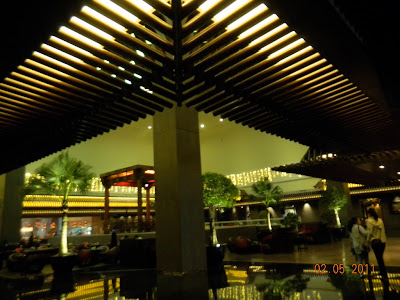If it was any other hotel---it could have faded in to obscurity like other awful airport and conference hotels, but this is designed by world-renowned architect Arata Isozaki and the first Jumeriah in China, from a brand that boasts 7 star facilities such as the Burj Al Arab in Dubai.
The Jumeriah Himalaya seeks to be the new cultural hub in conjunction with SNIEC and anchoring Pudong from the abyss that surrounds it. As such, The Himalaya offers 401 rooms, 5 restaurants, an art gallery, 1,100 seat Daguan theater, conference space, rooftop infinity garden, 24 hour fitness, pool, and a slew of luxury shops. Outside is an austere landscape (rumored to be designed by his wife) of wheat stalks to contrast with the dramatic facade. We were not able to get up close but, the amorphous shape is representative of a forest and originally supposed to be steel until the cost of steel rose 10 fold. Now it is concrete.
Our studio team ate at the Arte Cafe on the day of the visit for their lunch buffet. Not the best, not the worst but then we toured the most important part of every hotel---the rooms!
 |
| My coworker Miki at Arte Cafe |
 |
| Deluxe Room (standard room) |
 |
| Premiere Room |
The Premiere Room was really quite strange (and probably a nightmare to layout) because it curved around the hotel's central "jade atrium and reflection garden". Furthermore, the windows were overlaid with fixed metal shutters forming the building's exterior facade! A beautiful room, but a poor view with the feeling of being behind bars. Don't stay at the Premiere Room if you want a view. The other rooms were fine though. The Grand Deluxe Suite's tub was my favorite and I don't even take baths.
 |
| Grand Deluxe Suite |
More pictures from the Jumeirah's own website here.







